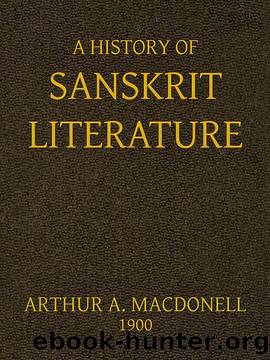A History of Sanskrit Literature by Arthur Anthony Macdonell

Author:Arthur Anthony Macdonell
Language: eng
Format: mobi
Tags: Sanskrit literature -- History and criticism
Published: 2012-12-05T05:00:00+00:00
CHAPTER X
THE EPICS
(CIRCA 500â50 B.C.)
In turning from the Vedic to the Sanskrit period, we are confronted with a literature which is essentially different from that of the earlier age in matter, spirit, and form. Vedic literature is essentially religious; Sanskrit literature, abundantly developed in every other direction, is profane. But, doubtless as a result of the speculative tendencies of the Upanishads, a moralising spirit at the same time breathes through it as a whole. The religion itself which now prevails is very different from that of the Vedic age. For in the new period the three great gods, BrahmÄ, Vishá¹u, and Ãiva are the chief objects of worship. The important deities of the Veda have sunk to a subordinate position, though Indra is still relatively prominent as the chief of a warriorâs heaven. Some new gods of lesser rank have arisen, such as Kubera, god of wealth; Gaá¹eça, god of learning; KÄrttikeya, god of war; ÃrÄ« or LakshmÄ«, goddess of beauty and fortune; DurgÄ or PÄrvatÄ«, the terrible spouse of Ãiva; besides the serpent deities and several classes of demigods and demons.
While the spirit of Vedic literature, at least in its earlier phase, is optimistic, Sanskrit poetry is pervaded by Weltschmerz, resulting from the now universally accepted doctrine of transmigration. To that doctrine, according to which beings pass by gradations from BrahmÄ through men and animals to the lowest forms of existence, is doubtless also largely due the fantastic element characteristic of this later poetry. Here, for instance, we read of Vishá¹u coming down to earth in the shape of animals, of sages and saints wandering between heaven and earth, of human kings visiting Indra in heaven.
Hand in hand with this fondness for introducing the marvellous and supernatural into the description of human events goes a tendency to exaggeration. Thus King ViçvÄmitra, we are told, practised penance for thousands of years in succession; and the power of asceticism is described as so great as to cause even the worlds and the gods to tremble. The very bulk of the MahÄbhÄrata, consisting as it does of more than 200,000 lines, is a concrete illustration of this defective sense of proportion.
As regards the form in which it is presented to us, Sanskrit literature contrasts with that of both the earlier and the later Vedic period. While prose was employed in the Yajurvedas and the BrÄhmaá¹as, and finally attained to a certain degree of development, it almost disappears in Sanskrit, nearly every branch of literature being treated in verse, often much to the detriment of the subject, as in the case of law. The only departments almost entirely restricted to the use of prose are grammar and philosophy, but the cramped and enigmatical style in which these subjects are treated hardly deserves the name of prose at all. Literary prose is found only in fables, fairy tales, romances, and partially in the drama. In consequence of this neglect, the prose of the later period compares unfavourably with that of the BrÄhmaá¹as. Even the
Download
This site does not store any files on its server. We only index and link to content provided by other sites. Please contact the content providers to delete copyright contents if any and email us, we'll remove relevant links or contents immediately.
| Africa | Americas |
| Arctic & Antarctica | Asia |
| Australia & Oceania | Europe |
| Middle East | Russia |
| United States | World |
| Ancient Civilizations | Military |
| Historical Study & Educational Resources |
Machine Learning at Scale with H2O by Gregory Keys | David Whiting(4183)
Never by Ken Follett(3791)
Fairy Tale by Stephen King(3220)
The Man Who Died Twice by Richard Osman(2997)
Oathbringer (The Stormlight Archive, Book 3) by Brandon Sanderson(2881)
Will by Will Smith(2793)
Rationality by Steven Pinker(2291)
The Dark Hours by Michael Connelly(2243)
Can't Hurt Me: Master Your Mind and Defy the Odds - Clean Edition by David Goggins(2228)
The Dawn of Everything: A New History of Humanity by David Graeber & David Wengrow(2122)
Friends, Lovers, and the Big Terrible Thing by Matthew Perry(2119)
Principles for Dealing With the Changing World Order: Why Nations Succeed and Fail by Ray Dalio(1974)
HBR's 10 Must Reads 2022 by Harvard Business Review(1777)
A Short History of War by Jeremy Black(1762)
Go Tell the Bees That I Am Gone by Diana Gabaldon(1687)
515945210 by Unknown(1599)
A Game of Thrones (The Illustrated Edition) by George R. R. Martin(1589)
Kingdom of Ash by Maas Sarah J(1526)
443319537 by Unknown(1470)
